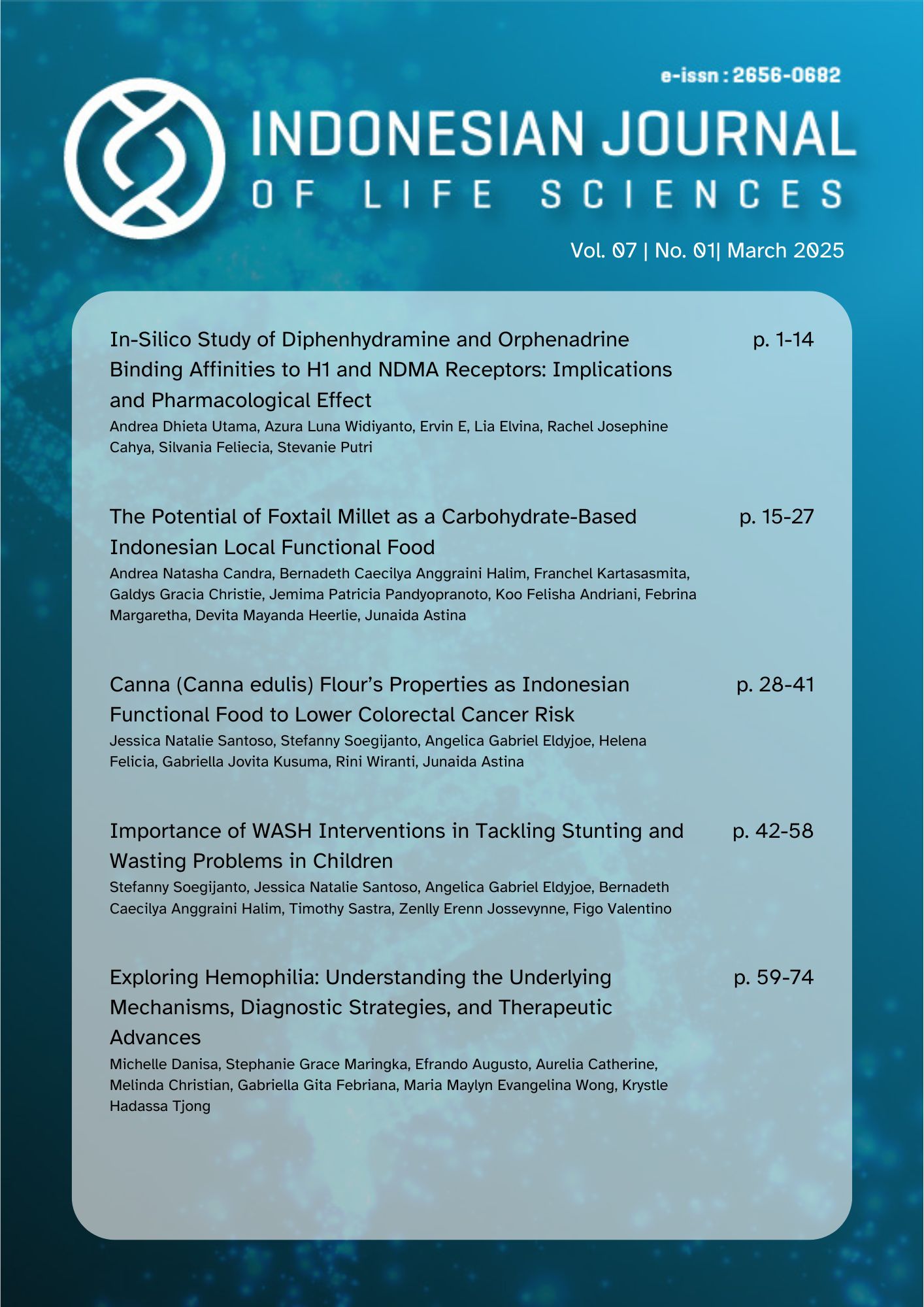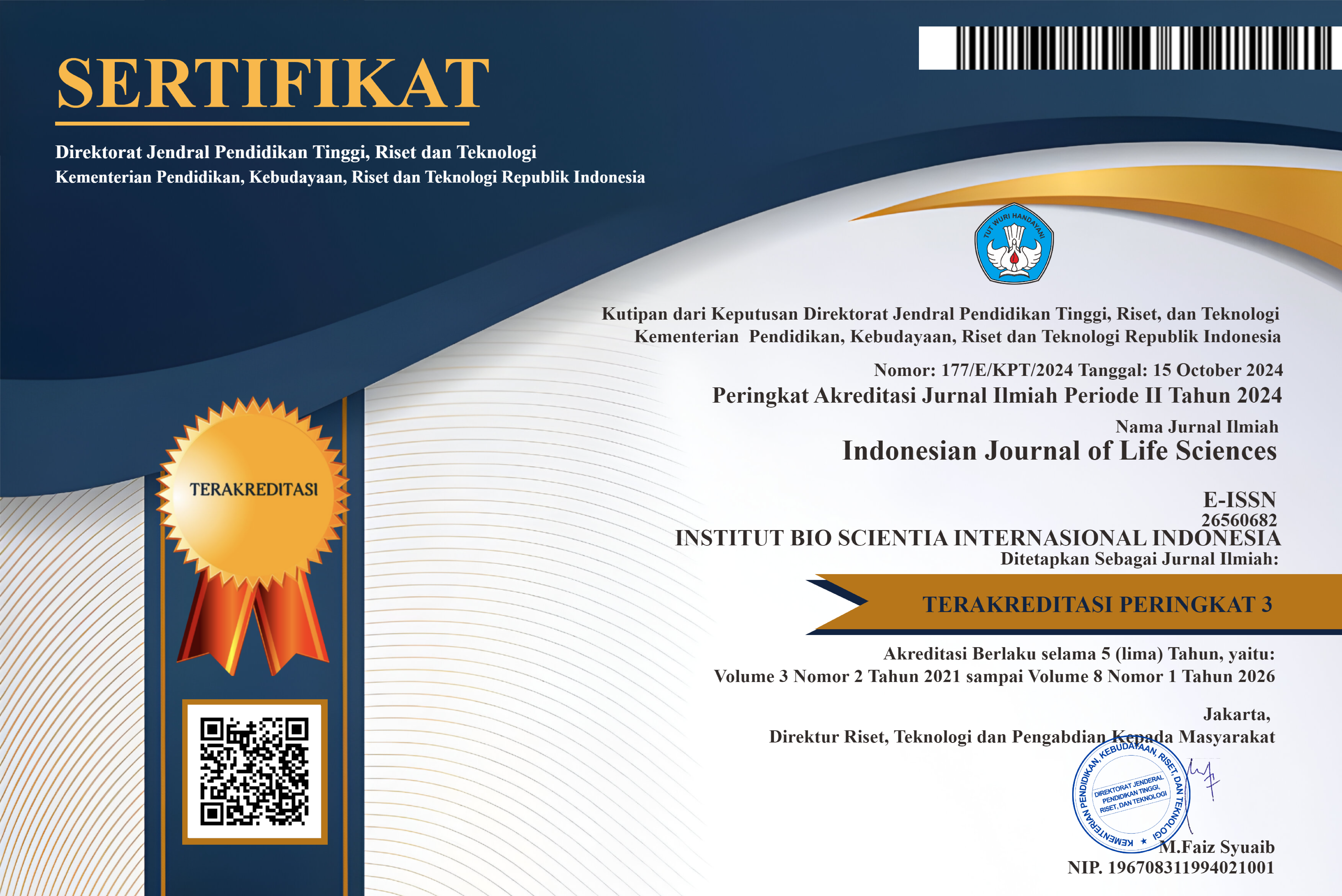In-Silico Study of Diphenhydramine and Orphenadrine Binding Affinities to H1 and NMDA Receptors: Implications for Pharmacological Effects
Abstract
Diphenhydramine and orphenadrine are oral drugs designed to possess different functional groups that affect H1 and NMDA receptors, although for different purposes. This study compares their binding affinities with the two receptors to investigate whether it influences the differing pharmacological effects exerted. This could help better understand the mechanisms, benefits, and risks of the drugs. The physicochemical properties were analyzed using Swiss-ADME, while the binding affinities were tested by molecular docking with PyRx. Lastly, visualization and analysis were done using the BIOVIA Drug Discovery Studio. The result suggests that both drugs have the same affinity for H1 receptors, however, orphenadrine has a slightly higher affinity to NMDA than diphenhydramine. This finding suggests that the binding ability and affinity of orphenadrine to NMDA is the factor of its pharmacological effect difference compared to diphenhydramine. Moreover, the difference in the functional group possessed by the two drugs will make a difference in their absorption and distribution.
Downloads
References
randomized single-dose, two-period crossover bioequivalence study of two fixed-dose Paracetamol/Orphenadrine combination preparations in healthy volunteers under fasted condition. BMC Pharmacology and Toxicology, 21(1). https://doi.org/10.1186/s40360-020-00416-3
DailyMed. (n.d.). DailyMed - TECNU CALAGEL- diphenhydramine hydrochloride gel. Dailymed.nlm.nih.gov. Retrieved May 6, 2024, from https://dailymed.nlm.nih.gov/dailymed/drugInfo.cfm?setid=8bc9cbfe-1dd4-18ed-e053-2a95a90a7 966&audience=consumer
DrugBank. (2024). Orphenadrine. Go.drugbank.com. https://go.drugbank.com/drugs/DB01173#
DrugBank. (n.d.). Diphenhydramine: Uses, interactions, mechanism of action. https://go.drugbank.com/drugs/DB01075
DrugBank. (n.d.). pKa | DrugBank Help Center. Dev.drugbank.com. Retrieved June 19, 2024, from https://dev.drugbank.com/guides/terms/pka
Fadlan, A., & Nusantoro, Y. R. (2021). The Effect of Energy Minimization on The Molecular Docking of Acetone-Based Oxindole Derivatives. JKPK (Jurnal Kimia Dan Pendidikan Kimia), 6(1), 69. https://doi.org/10.20961/jkpk.v6i1.45467
Gelotte, C. K., Zimmerman, B. A., & Thompson, G. A. (2017). Single-Dose Pharmacokinetic Study of Diphenhydramine HCl in Children and Adolescents. Clinical Pharmacology in Drug Development, 7(4), 400–407. https://doi.org/10.1002/cpdd.391
Hossen, M. S., Akter, A., Azmal, M., Rayhan, M., Islam, K. S., Islam, M. M., Ahmed, S., & Abdullah-Al-Shoeb,
M. (2024). Unveiling the molecular basis of paracetamol-induced hepatotoxicity: Interaction of N-acetyl-p-benzoquinone imine with mitochondrial succinate dehydrogenase. Biochemistry and Biophysics Reports, 38, 101727–101727. https://doi.org/10.1016/j.bbrep.2024.101727
Jamelah S.Al-Otaibi, Mary, Y. Sheena., Mary, Y. Shyma., Armaković, S. J., Stevan Armaković, Christian Van Alsenoy, & H.S. Yathirajan. (2022). Insights into the reactivity properties, docking, DFT and MD simulations of orphenadrinium dihydrogen citrate in different solvents. Journal of Molecular Liquids, 367, 120583–120583. https://doi.org/10.1016/j.molliq.2022.120583
Karami, T. K., Hailu, S., Feng, S., Graham, R., & Gukasyan, H. J. (2022). Eyes on Lipinski’s Rule of Five: A New “Rule of Thumb” for Physicochemical Design Space of Ophthalmic Drugs. Journal of Ocular Pharmacology and Therapeutics, 38(1), 43–55. https://doi.org/10.1089/jop.2021.0069
Kastritis, P. L., & Bonvin, A. M. J. J. (2013). On the binding affinity of macromolecular interactions: daring to ask why proteins interact. Journal of the Royal Society Interface, 10(79), 20120835. https://doi.org/10.1098/rsif.2012.0835
Kralj, S., Marko Jukić, & Bren, U. (2023). Molecular Filters in Medicinal Chemistry. Encyclopedia, 3(2), 501–511. https://doi.org/10.3390/encyclopedia3020035
Le, V. T. T., Nguyen, T. H. T., & Do, P.-C. (2024). Global ligand-protein docking tools: Comparation and Case study. IntechOpen EBooks. https://doi.org/10.5772/intechopen.1005158
Lexa, K. W., & Carlson, H. A. (2012). Protein flexibility in docking and surface mapping. Quarterly Reviews of Biophysics, 45(3), 301–343. https://doi.org/10.1017/s0033583512000066
Liu, Y.-J., Li, Y.-L., Fang, Z.-H., Liao, H.-L., Zhang, Y.-Y., Lin, J., Liu, F., & Shen, J.-F. (2022). NMDARs mediate
peripheral and central sensitization contributing to chronic orofacial pain. Frontiers in Cellular Neuroscience, 16. https://doi.org/10.3389/fncel.2022.999509
Manallack, D. T. (2007). The pKa Distribution of Drugs: Application to Drug Discovery. Perspectives in Medicinal Chemistry, 1, 1177391X0700100. https://doi.org/10.1177/1177391x0700100003
Manjooran, G. (2020). pKa and Ka (Acid dissociation constant). Southern African Journal of Anaesthesia and Analgesia, S108–S108. https://doi.org/10.36303/sajaa.2020.26.6.s3.2552
MedlinePlus. (2017). Orphenadrine: MedlinePlus Drug Information. Medlineplus.gov. https://medlineplus.gov/druginfo/meds/a682162.html
MedlinePlus. (2018). Diphenhydramine: MedlinePlus Drug Information. Medlineplus.gov. https://medlineplus.gov/druginfo/meds/a682539.html
Miller, M. (2020, September 11). Reader’s Digest: UC grad’s invention one of “most trusted brands” in health. UC News. https://www.uc.edu/news/articles/n20945579/readers-digest-highlights-invention-of-benadryl-by- ucs-rieveschl.html#:~:text=Rieveschl%20returned%20to%20UC%20in
Morak-Młodawska, B., Jeleń, M., Martula, E., & Korlacki, R. (2023). Study of Lipophilicity and ADME Properties of 1,9-Diazaphenothiazines with Anticancer Action. International Journal of Molecular Sciences, 24(8), 6970. https://doi.org/10.3390/ijms24086970
Multum, C. (2023). Orphenadrine Uses, Side Effects & Warnings. Drugs.com. https://www.drugs.com/mtm/orphenadrine.html
National Center for Biotechnology Information (2024). PubChem Compound Summary for CID 4601, Orphenadrine. Retrieved May 6, 2024 from https://pubchem.ncbi.nlm.nih.gov/compound/Orphenadrine.
National Institute of Diabetes and Digestive and Kidney Diseases. (2012). Orphenadrine. In PubMed. National Institute of Diabetes and Digestive and Kidney Diseases. https://www.ncbi.nlm.nih.gov/books/NBK548850/
Obara, I., Telezhkin, V., Alrashdi, I., & Chazot, P. L. (2019). Histamine, histamine receptors, and neuropathic pain relief. British Journal of Pharmacology, 177(3). https://doi.org/10.1111/bph.14696
Pandit, R., Chen, L., & Götz, J. (2020). The blood-brain barrier: Physiology and strategies for drug delivery.
Advanced drug delivery reviews, 165, 1-14.
Pantsar, T., & Poso, A. (2018). Binding affinity via docking: fact and fiction. Molecules/Molecules Online/Molecules Annual, 23(8), 1899. https://doi.org/10.3390/molecules23081899
Patel, H. M., Noolvi, M. N., Sharma, P., Jaiswal, V., Bansal, S., Lohan, S., Kumar, S. S., Abbot, V., Dhiman, S., & Bhardwaj, V. (2014). Quantitative structure–activity relationship (QSAR) studies as strategic approach in drug discovery. Medicinal Chemistry Research, 23(12), 4991–5007. https://doi.org/10.1007/s00044-014-1072-3
Pathak, S., Mishra, A., Sonawane, G., Sonawane, K., Rawat, S., Raizaday, A., Singh, S. K., & Gupta, G. (2023). In silico pharmacology. In Elsevier eBooks (pp. 1–52). https://doi.org/10.1016/b978-0-323-99137-7.00006-x
Price, G., & Patel, D. A. (2020). Drug bioavailability.
PubChem. (2005). Diphenhydramine. Pubchem.ncbi.nlm.nih.gov. https://pubchem.ncbi.nlm.nih.gov/compound/Diphenhydramine#section=Absorption-Distribution- and-Excretion
PubChem. (2024). Orphenadrine. Pubchem.ncbi.nlm.nih.gov. https://pubchem.ncbi.nlm.nih.gov/compound/Orphenadrine
Salahudeen, M. S., & Nishtala, P. S. (2017). An overview of pharmacodynamic modelling, ligand-binding approach and its application in clinical practice. Saudi Pharmaceutical Journal, 25(2), 165–175. https://doi.org/10.1016/j.jsps.2016.07.002
Sicari, V., & Zabbo, C. P. (2020). Diphenhydramine. PubMed; StatPearls Publishing. https://www.ncbi.nlm.nih.gov/books/NBK526010/#:~:text=Mechanism%20of%20Action
Singh, K., Senatorov, I. S., Cheshmehkani, A., Karmokar, P. F., & Moniri, N. H. (2022). The skeletal muscle relaxer cyclobenzaprine is a potent non-competitive antagonist of histamine H1 receptors. Journal of Pharmacology and Experimental Therapeutics, 380(3), 202–209. https://doi.org/10.1124/jpet.121.00099
Torres, P. H. M., Sodero, A. C. R., Jofily, P., & Silva-Jr, F. P. (2019). Key Topics in Molecular Docking for Drug Design. International Journal of Molecular Sciences, 20(18), 4574.
https://doi.org/10.3390/ijms20184574
Velmourougane, G. (2022, February 7). Understanding Lipinski’s Rule of 5 and the Role of LogP Value in Drug Design and Development. Sai Life Sciences. https://www.sailife.com/understanding-lipinskis-rule-of-5-and-the-role-of-logp-value-in-drug-desig n-and-development/
Waldman, S. D. (2009). CHAPTER 347 - Skeletal Muscle Relaxants. Pain Review, 651–656. https://www.sciencedirect.com/science/article/pii/B9781416058939003476
Zafar, F., Gupta, A., Thangavel, K., Khatana, K., Sani, A. A., Ghosal, A., Tandon, P., & Nishat, N. (2020). Physicochemical and Pharmacokinetic Analysis of Anacardic Acid Derivatives. ACS Omega, 5(11), 6021–6030. https://doi.org/10.1021/acsomega.9b04398

This work is licensed under a Creative Commons Attribution-NonCommercial-ShareAlike 4.0 International License.
Articles published in Indonesian Journal Life of Sciences are licensed under a Creative Commons Attribution-ShareAlike 4.0 International license. You are free to copy, transform, or redistribute articles for any lawful purpose in any medium, provided you give appropriate credit to the original author(s) and Indonesian Journal Life of Sciences, link to the license, indicate if changes were made, and redistribute any derivative work under the same license. Copyright on articles is retained by the respective author(s), without restrictions. A non-exclusive license is granted to Indonesian Journal Life of Sciences to publish the article and identify itself as its original publisher, along with the commercial right to include the article in a hardcopy issue for sale to libraries and individuals. By publishing in Indonesian Journal Life of Sciences, authors grant any third party the right to use their article to the extent provided by the Creative Commons Attribution-ShareAlike 4.0 International license.










